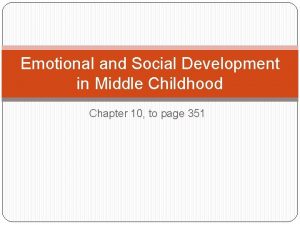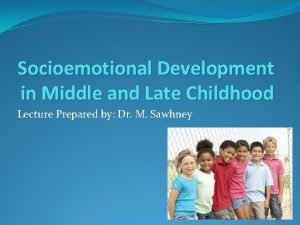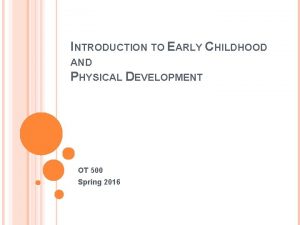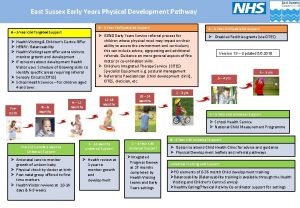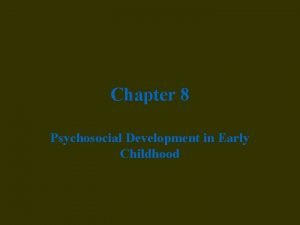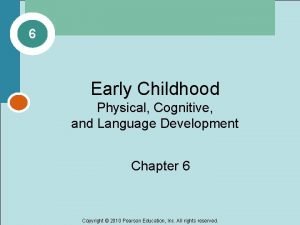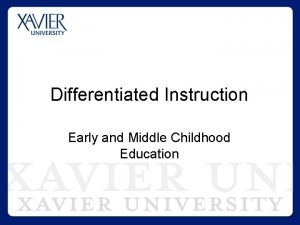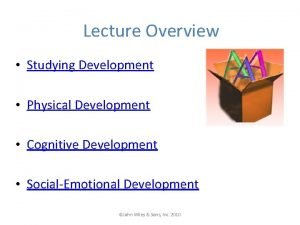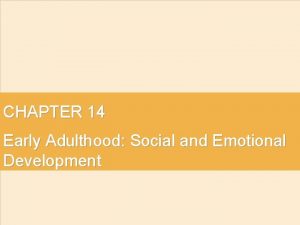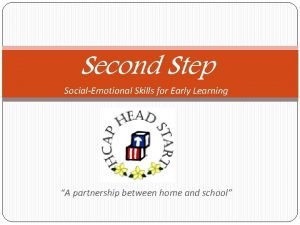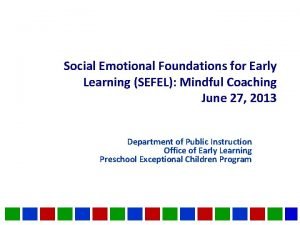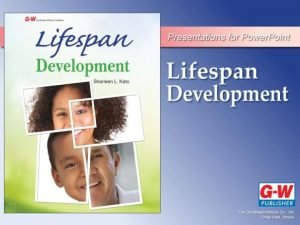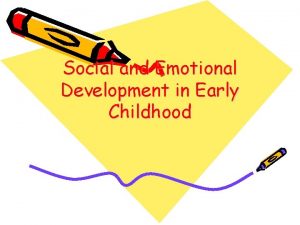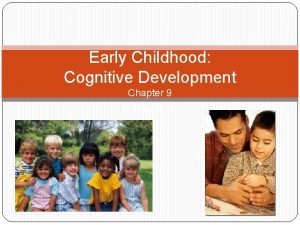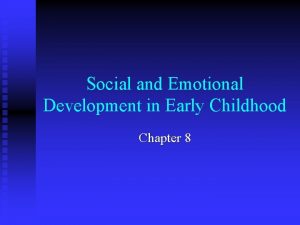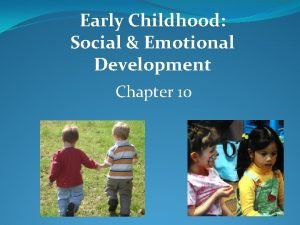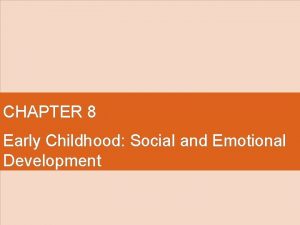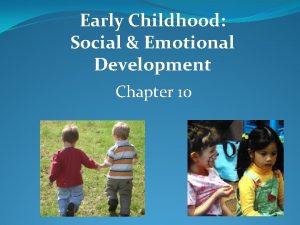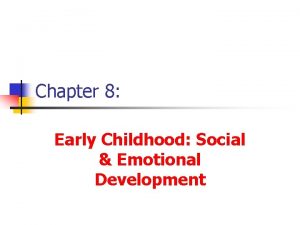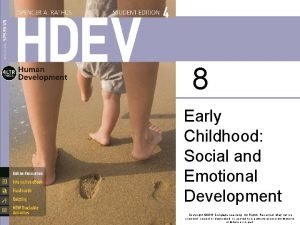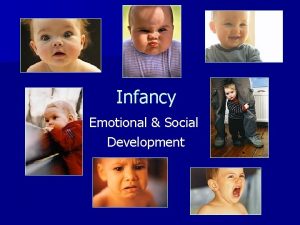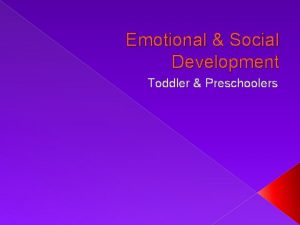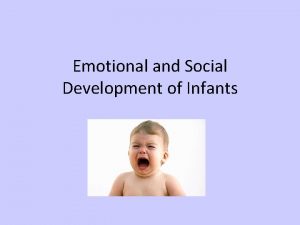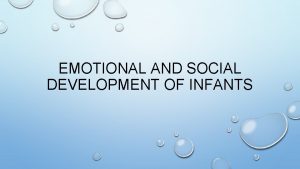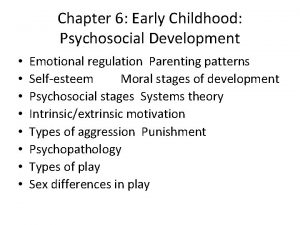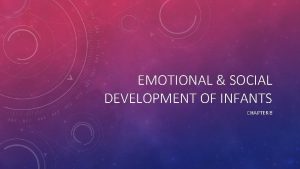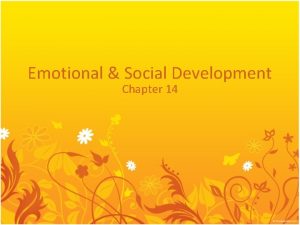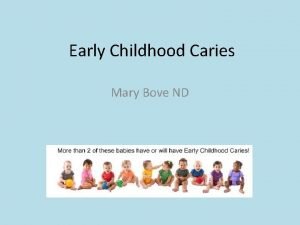Emotional Social Development In Early Childhood Chapter 10

















- Slides: 17

Emotional & Social Development In Early Childhood Chapter 10: pgs. 357 -369, 372379, 384 -396

Erikson’s Theory ______ Eagerness to try new tasks, join activities with peers Play permits trying out new skills, learning about self & social world Act out highly visible occupations & family scenes (pg 357) _____ Overly strict superego, or conscience, causing too much guilt Related to excessive threats, criticism, punishment from adults

Self-concept & Self-esteem (pg 358) _____________emerges, as language development enables children to talk about their own subject experience of being _______-the set of attributes, abilities, attitudes, and values that an individual believes defines who he or she is 3 -5 yrs old=very ______: observable characteristics such as their name, physical appearance, possessions, & everyday behaviors (Harter, 2006; Watson, 1990) begin to understand life-story narratives and video images of themselves (age 4) ______-judgments we make about our own worth 4 yrs old=have several self-judgments (learning things well in school, making friends)

Emotional Development (pg 361) Make great strides between 2 -6 yrs old understanding of others’ emotions becomes more accurate; better able to talk about feelings emotional _________ improves empathy, sympathy, and prosocial behavior increases _______ strongly influences preschoolers’ emotional competence 4 -5 yrs=correctly judge the causes for basic emotions (“He’s happy because he’s…”)

Emotional Development…cont’d Children gain __________ through _________ the more parents _______feelings, the better developed their emotional understanding is parents who are in tune with their own emotional experiences tend to be supportive & patient with their preschoolers, offering suggestions & explanation ________________________ helps children to improve their ability to manage their emotions (“_______”) begin to use _______ to inhibit impulses & shift attention ________ affects the development of self-regulation

Emotional Development…cont’d Preschoolers become sensitive to ______ & _______ experience _________ (feelings that involve injury to or enhancement of their sense of self) ____ serves as a motivator for ____ or altruistic behavior (actions that benefit another person without any expected reward for the self) Temperament and _________ affect empathy & sympathy

CSEFEL Pyramid Model _______=Center on the Social Emotional Foundations for Early Learning § A model to support children’s _______ and to _____________ (Fox et al. , 2003) § 1. effective workplace (yellow tier) § 2. engage in __________ (blue tier) § 3. develop ____________ (blue tier) § 4. provide systematic, explicit social & emotional support & instruction (green) § 5. develop and implement an individualized intervention (red tier) ** Start at bottom of pyramid and work your way up; each step is increasingly intensive, but is needed by fewer children

Peer Relations & Sociability in Play 2 -5 yrs=rise in joint, interactive play (Mildred Parten, 1932) 3 -step sequence: (pg 365) (Allyn & Bacon, 2008) v. Unoccupied, onlooker behavior _____ v. Solitary play v. Limited form of social interaction _____ v. Plays near other children with _____ similar toys, but does not try to influence them v. Associative play-engage in separate _____ activities but exchange toys/make comments _____ v. Cooperative play-children orient towards a common goal during play

Developmental Sequence of Cognitive Play Categories (Table 10. 1, pg 367) Each type of play (nonsocial, parallel, cooperative) displays the cognitive maturity of the child into 3 different play categories: (Allyn & Bacon, 2008) Simple, repetitive motor movements, with or without objects Creating or constructing something 0– 2 years Acting out everyday and ______ imaginative roles Play 2– 6 years _____ Play ______ Play 3– 6 years

Lecture Supplements Handout-Caring for Preschoolers in Child Care… Quote-Frobel “Play” _________-an advanced form of cooperative play ______ participate more in sociodramatic play, where _____ participate in more in friendly, vigorous interactions called ____________ ○ both require children to understand emotions, exercise self-control, and respond to other children’s verbal/nonverbal cues

Friendships… first friendships important for _____ and ______ development preschoolers definition… someone “who likes you” and with whom you spend a lot of time playing 4 -7 yrs=more pleasurable & sharing of toys change frequently social ability contributes to academic performance _____________=________ in 1 st grade (Konold & Pianta, 2005) children who begin kindergarten w/friends in their class or readily make new friends adjust to school more favorably (Proulx & Poulin, 2013)

Gender Typing (pg 384) -an association of _______, or _______ with one sex or the other in ways that conform to cultural stereotypes (Liben & Bigler, 2002) ___ yrs=use words such as “boy, ” “girl, ” “man” Preschoolers associate toys, clothing , tools, household items, colors, etc with one sex or the other (Giles & Heyman, 2005) _______ reflect _______ boys-active, impulsive, assertive, overtly aggressive girls-more fearful, dependent, compliant, considerate, emotionally sensitive (Bosacki & Moore, 2004)

Gender Typing…cont’d Influences: ______ (biological)-sex hormones affect human play styles ○ __________ (unemployment, divorce, death) may influence prenatal hormones, and it has been linked to “masculine” behaviors among preschool girls (Barrett et al. , 2014) _________ ○ family & parenting practices-expectations, gender- appropriate toys fathers, especially, tend to insist boys conform to gender roles ○ teachers-emphasize gender differences ○ peers-as the time spent w/same sex play partners increases, so does gender-type beliefs ○ broader social environment-occupations, leisure activities, TV

Gender Identity (pg 389) ________-an image of oneself as relatively masculine/feminine in characteristics _______-understanding that gender remains the same over time _________-realization that gender in not altered by superficial changes in clothing or activities

Child Rearing (pg 392) _________-combinations of parenting behaviors that occur over a wide range of situations, creating an enduring, child-rearing climate three features that consistency differentiate an effective style from a less effective style __________________

Styles of Child Rearing ______ Authoritarian (pg 393, Table 10. 2) • the ________________ • high acceptance & involvement; warm, attentive & sensitive to child’s needs • exercises firm, reasonable control • child makes some appropriate decisions on own (gradual, appropriate autonomy granting) • ______________; appears cold & rejecting • makes many demands, uses _____________ • makes all decisions for the child; rarely listens to child’s point of view ______ • warm & accepting, but overindulgent or inattentive • makes little effort to control child’s behavior; makes few or little demands • allows children to make many decisions for themselves at any age, even when they are not capable of doing so Uninvolved • low acceptance & involvement; emotionally detached/depressed, overwhelmed w/life • makes little effort to be a part of the child’s life; makes few or no demands • indifferent to the child’s decision making & point of view • a form of child maltreatment/neglect

Positive Parenting & Positive Discipline Strategy Explanation Use transgressions as opportunities to teach When child engages in unsafe behavior, intervene firmly & instruct to behave prosocially Reduce opportunities for misbehavior Ex. on long car trips=provide activities Ex. at supermarket=let them help with shopping Provide reasons for rules Make sure reasons are fair to all concerned, rules should be reasonable & rational Arrange for children to participate in family routines & duties Children develop a sense of responsible participation in family & community life When children are obstinate, try compromising & problem solving First, express understanding of the child’s feelings, suggest a compromise, help to problem solve an appropriate solution Encourage mature behavior Express confidence in child’s abilities & appreciation for effort & cooperation, adult encouragement goes a long way! Be sensitive to children’s physical & emotional resources When children are tired, ill, or bored, they are likely to engage in improper behaviors; help to meet the child’s needs
 Middle childhood emotional development
Middle childhood emotional development Middle childhood years
Middle childhood years A vygotskian classroom promotes ________.
A vygotskian classroom promotes ________. Middle and late childhood
Middle and late childhood Fine motor skills development in early childhood
Fine motor skills development in early childhood Physical development in early childhood
Physical development in early childhood Psychosocial development in early childhood
Psychosocial development in early childhood Language development in early childhood
Language development in early childhood Biosocial development in early childhood
Biosocial development in early childhood Early childhood development with differentiated instruction
Early childhood development with differentiated instruction Cognitive development in childhood
Cognitive development in childhood Physical changes in adulthood
Physical changes in adulthood Social development in early adulthood
Social development in early adulthood Second step social emotional skills for early learning
Second step social emotional skills for early learning Sefel training
Sefel training Types of early childhood programs activity a chapter 2
Types of early childhood programs activity a chapter 2 Chapter 7 early childhood ages 3 through 5
Chapter 7 early childhood ages 3 through 5 Social development in infancy and childhood
Social development in infancy and childhood
